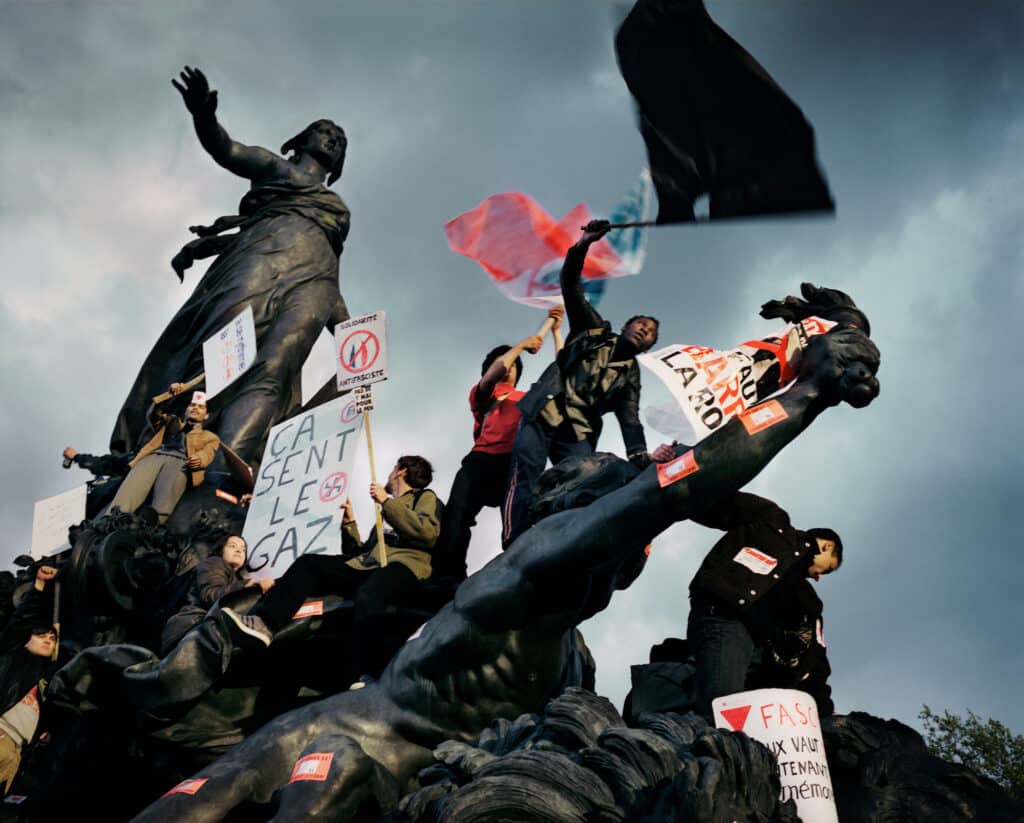“Some mornings, Libération was the most beautiful daily in the world”
Who hasn’t, like Serge July, co-founder of the daily newspaper conceived in 1973, said the same thing to themselves when walking past a newsstand? The “Libé touch” is the art of the headline and, above all, of the front-page photograph. It’s been half a century that July has been eyeing and shaking up the news, apparently without even getting cataracts. 50 Years Through the Eyes of Libération is a tribute to the photographers, editors, and staff who have put photography in the spotlight: fifty years of history recounted in images by the greats; fifty years of archives, negatives, and prints that bear witness to the tumult of the world with grit, provocation, and poetry.
The 300 photographs presented in the book recount a shared history, but above all, as Lionel Charrier—photo director of the left-leaning newspaper since 2015, as well as cofounder and director of Agence M.Y.O.P.—puts it, they illustrate “the spirit of framing, composition, that spirit of rebellion and curiosity.” With journalist Charlotte Rotman, Charrier scoured 400 boxes of archives, most of them stored in an impersonal warehouse 35 km outside of Paris, in order to “cover 50 years’ worth of events through the eyes of photographers.”
Image culture
Henri Cartier-Bresson, William Klein, Paolo Roversi, Gilles Peress, Martine Franck, Sebastião Salgado, Françoise Huguier, Raymond Depardon…: publishing a photo in Libération is to become part of a unique photographic heritage. Charrier and Rotman celebrate this treasure trove of auteur photography in the service of current events: thousands of prints, in black-and-white and color, document five decades of our existence.
They had to launch into a major investigation, call up photographers, photo editors, and journalists, take down back stories to the photos, going behind the scenes of this offbeat newspaper. Charrier unearthed some delightful nuggets, like the photograph of President Valéry Giscard d’Estaing taken by Jacques Torregano, which made the front page of Libération in May 1981 as the politician was leaving the Elysée Palace. The photographer shared a curious anecdote: “Giscard was on the campaign trail, and we followed him up the stairs of a building in Paris. He climbed the stairs four at a time to look young. We were crammed. I took the photo, but in the jostle, my synchroflash moved and got set to 250: only the lower part of the image was lit.” The president’s shadow silhouette appears in a window frame. “To me this was a dud, I didn’t want to show it, but we took the print to Libé,” recounts Torregano. “When Giscard lost, the paper used this image on the cover. With a headline that unwittingly referred to this photographic accident: Curtain.” Who better than Libé to use a photo that was a priori botched.
“Every image hides a pithy story. The aim of the book is to show the newspaper’s photographic DNA,” explains Charrier, admitting he had embarked on a personal quest to truly understand the origins of this special relationship between the daily newspaper and the photographic medium. “I was looking for the rationale that inspired this genuine photo policy. When you talk about photography at Libération, you must go beyond the front and back pages. Photography doesn’t just exist for its own sake, but because there’s a culture supported by the newspaper.”
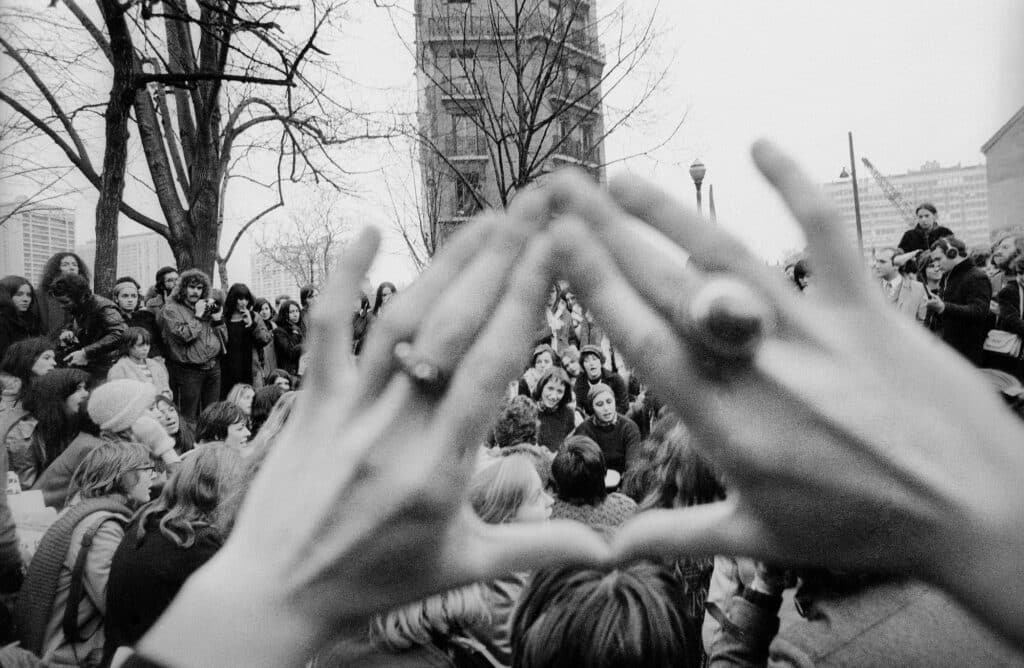
The Libé mindset
To understand this particular alchemy, we need to rewind to the newspaper’s early years. A great lover of cinema, the daily’s cofounder Serge July had quickly understood the importance of telling the world through images. The special connection with photography is also, and above all, explained by the creation of an in-house photo agency: Photolib. “Photolib was in charge of the photo service. The seed of photography had been planted,” notes Charrier.
It would take a decade or so for what came to be known “Une affiche,” or the “poster front-page,” to fully blossom. One day in April 1980, on the occasion of Jean-Paul Sartre’s death, Christian Caujolle, the newspaper’s photographic columnist at the time, came across a photograph by Antanas Sutkus showing the philosopher and his shadow struggling against the wind, his head leaning forward, hands behind his back. The “poster font-page” became official, although a special issue back in 1976 had already paid tribute to Mao with a full-page photo of the Great Helmsman.
“Christian Poulin, who was developing the films, was totally distraught at the idea of screwing up Cartier-Bresson’s negatives”
Christian Caujolle
In the early 1981, the new format of the newspaper-magazine, conceived by Serge July, Claude Maggiori, and Frédérique Goursolas, adopted its first photo policy under the leadership of Christian Caujolle, cofounder of the Agence VU’, as director of Libé’s photo department. “One of the strong points of this policy of auteur photography was to produce as much as possible to set ourselves apart from other newspapers. We analyzed the French daily press and realized that it hadn’t changed at all since 1945,” says Caujolle. Currently the artistic advisor to the Château d’Eau gallery in Toulouse, he recalls actively seeking out artists to commission. In May 1981, Caujolle took on the challenge of convincing Magnum photographers in Paris to cover François Mitterrand’s inauguration. It was his first assignment as head of the photo department. The special twelve-page issue—one of his most memorable—had to be published by 6 p.m. that very day.
All the films shot in the morning would be collected and developed as quickly as possible to meet the deadline. “Christian Poulin, who was developing the films, was totally distraught at the idea of screwing up Cartier-Bresson’s negatives, so we were obviously late, but we managed and had a lot of fun,” recounts Caujolle. Cartier-Bresson even said: “I’ve never seen a photo of mine developed that fast!” In the book, the episode is recounted in a touching double-page spread (pp. 54–5), with Cartier-Bresson’s photo, taken inside the Elysée Palace on the left-hand side, and that of his companion, Martine Franck, shot in the forecourt, on the right. The Cartier-Bresson photo did not make it into Libé but was printed as a double-page spread in Paris-Match. “I went to print without even doing the contact sheets. There was no time. That photo of the cooks inside the Elysée Palace watching Mitterrand’s arrival… I had missed it!,” admits Caujolle.
One step to the side
Libération sidesteps conventions: we frame a little too closely, we cut heads off, we subvert the codes of news photography. This is a photographer’s playground: “the eyebrow and the hammer” is a case in point. In February 1985, at the French Communist Party Congress in Saint-Ouen, Jean-Claude Coutausse captured the top of the head of Georges Marchais, then General Secretary of the Party, peeking above the edge of a giant rostrum flanked by two hammers and sickles. “Doing a photo for AFP [Agence France Presse], which I used to work for, meant doing a photo that could go anywhere, so you had to comply. Libé gives you immense freedom to express yourself … it allows you to make images that stand out,” says the photographer.
“I had to pick up the photos in Neuilly; they arrived almost every day from the United States in the same suitcase as the Herald Tribune advertisements, via the Concorde”
Christian Caujolle
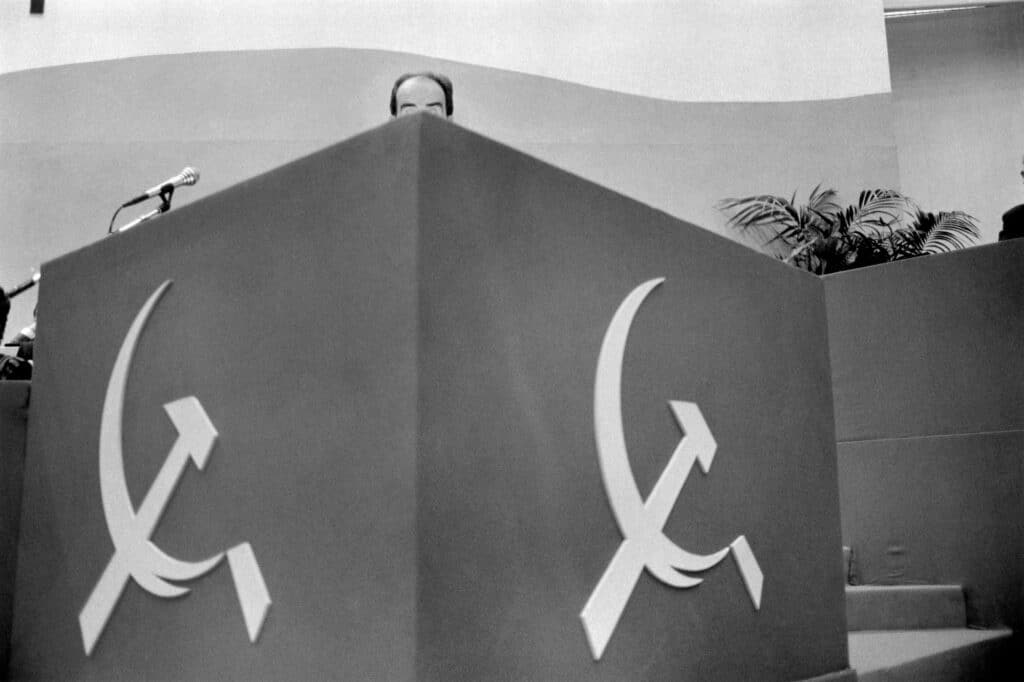
Caujolle had a flair for sparking creativity. One summer, he gave Raymond Depardon carte blanche to do a photo diary in New York. “I had to pick up the photos in Neuilly; they arrived almost every day from the United States in the same suitcase as the Herald Tribune advertisements, via the Concorde. They didn’t always make it into the paper, and some people in the editorial office thought we were wasting half a page a day,” recalls the then-head of photography, who would never renounce his editorial vision. He sent William Klein to Lourdes for the Pope’s visit in 1980. “At the time, no one in the press was working with William Klein. … I liked him, he was a sort of endearing troublemaker. For the Pope’s visit to Lourdes, I needed an irreverent eye. … At Lourdes, it’s forbidden to photograph the baths. Of course, he did photograph them; and, of course, we did publish the picture,” Caujolle recollected with relish.
Libé the irreverent, Libé the rule-breaker. Annual events, such as Cannes or fashion shows, are always an opportunity to reinvent oneself and stand out. Françoise Huguier went backstage at the biggest fashion shows; Bruce Gilden and his terrible flash went hunting for faces, necklines, and high heels at the Croisette… To this day, the newspaper holds on to the soul of auteur photography put in the service of current events. “The spirit is still alive, and there will always be a place for photography,” affirms Caujolle.
“Libé was a school of life”
Photographer Frédéric Stucin knows what he’s talking about: he is a product of Libé through and through. The year 1999 was the first summer he spent at the newspaper, “elbows deep in the photo lab.” He was in his twenties, and didn’t know much about photography. “I hardly even knew who Cartier-Bresson was,” he admits. “But at Libé, it was magical to see how a daily paper was put together. Straight away, you were confronted with some wacky photos. I loved hanging out in the archives, diving into the boxes, and coming out with treasures.”
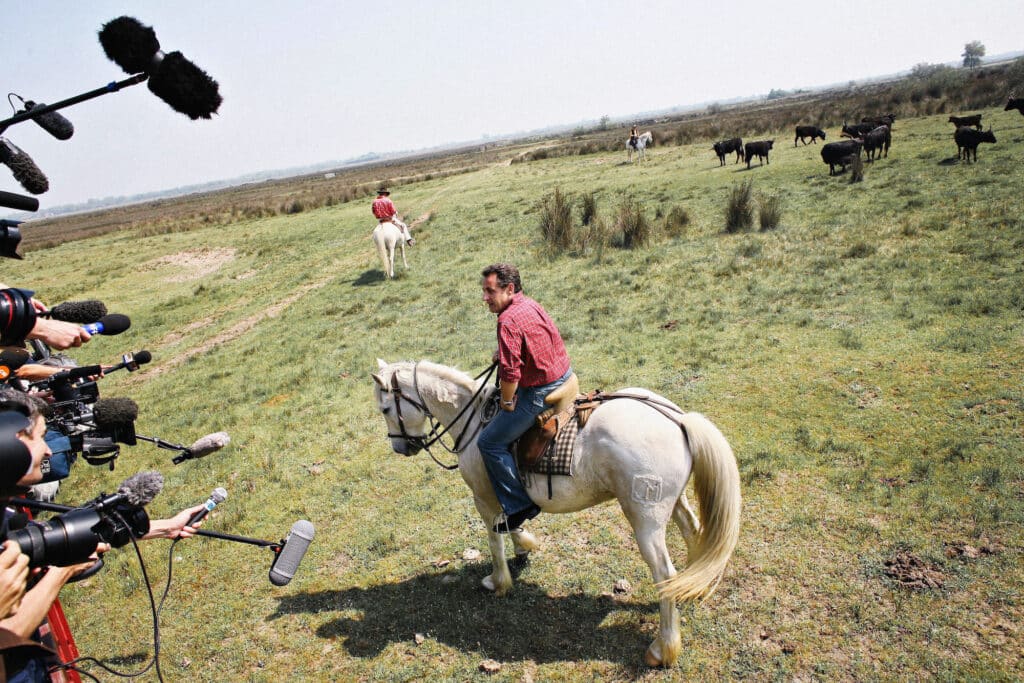
“When you do your first back page, you’re like jumping for joy!“
Frédéric Stucin, photographer
The apprentice lab technician gradually acquired a taste for photography and wanted to get out into the field. “I went and asked the management. They sent me to cover a demonstration in Seine-Saint-Denis. I went there. When I came back, they told me it sucked. So you go and get out there again. That’s how you learn!” There are no bad subjects, only bad photographers. Stucin learned, and tried his hand at everything. “In the morning, you’re doing a portrait of an unknown theatre director; in the afternoon, you’re at a demonstration of undocumented immigrants; in the evening, you’re in a drug-addict squat, before heading off to a bike race the following day… Libé was a school of life.”
Having covered the news, Stucin began filling Libération’s prestigious back page, the portrait page (created in 1994). “When you do your first back page, you’re like jumping for joy! It’s a very sought-after assignment. It’s like the cherry on top; and it means incredible visibility.” The freelance photographer acknowledges the carte blanche Libération extends to its photographers and the paper’s offbeat approach: “Libération’s trademark is freedom: the freedom in the image register, the freedom to go digging for trouble.” This is illustrated by one of his photos featured in the book (p. 236), taken during Nicolas Sarkozy’s presidential campaign at Mont Saint-Michel in 2007. The communications department deliberately placed the photographers face to face with the politician, with the beautiful view of the bay in the background. “They wanted a historic photo. Obviously, at Libé we won’t be satisfied that easily… So I broke away from the group to present the scene in its entirety. And, of course, the photo department chose this offbeat image,” Stucin writes. Sarkozy is relegated to the bottom right of the image, facing a swarm of photographers, cameramen, and sound engineers. “We are asked to push the envelope in our photographs and seek out the photographic moment, rather than just being illustrative. Images don’t need text. An image must be able to tell a story all by itself. I’ve never found the same freedom anywhere else,” says the photographer, who likes to spotlight the new generation, such as the back-page portrait of the aptly named Boby.
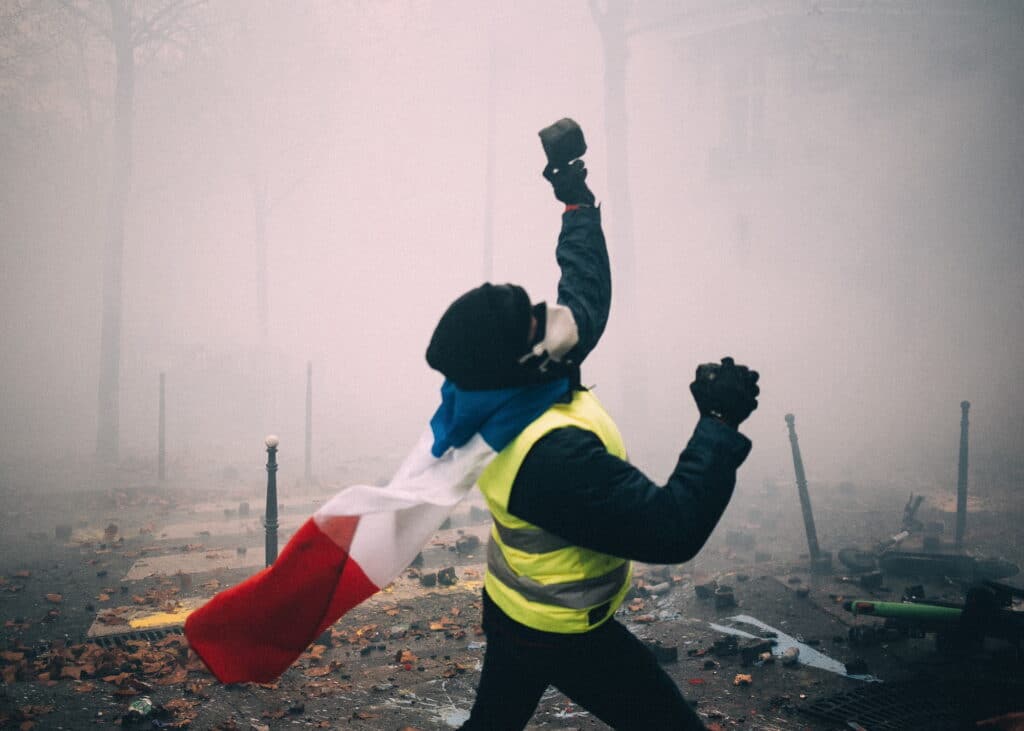
“We must guarantee the veracity of the image”
Since its creation, Libération has been covering struggle, from the Lip watch factory workers’ strike to the Yellow Vests, from Sartre to Macron; it has borne witness to the world, from the Vietnam War to Chechnya, to the Fall of the Berlin Wall to September 11… The daily continues to carry on that struggle, maintaining its attachment to the image, down through the digital revolution and the challenges it entails.
Charrier took over as the head of the photo department on January 5, 2015. Two days later came the Charlie Hebdo attack. “I had barely the time to set up my computer, I had no software installed… You’re just thrown into the deep water: the news stops for no one, and it lays down its laws.” Faced with a flood of information and images, editorial composure becomes all the more essential. “We’re careful not to be sensationalist, to diversify our front page, and match the tone of the event. Libé has never been about ham-fisted words or shocking photos; rather, we have always sought narrative photography,” explains Charrier, who has launched Le Libé des photographes, a special issue in which photography is given even greater prominence.
“With this coming revolution, our task as photo editors is going to be key, as is the task of the press more generally. We must guarantee the veracity of the image”
Lionel Charrier
The newspaper often takes a stand and doesn’t hesitate to show what we would rather not see. On April 6, 2017, under the headline “The Children of Assad,” the daily printed on its front page the unbearable photo of children’s corpses, victims of the chemical attack on the village of Khan Cheikhoun, Syria, orchestrated by Bashar el-Assad. “This was one of our boldest, most assertive choices,” recalls Charrier. “We just had to break the taboo and show this painful image. We debated it a lot. Yes, it’s not a pretty sight, but when atrocities are being denied, you have to show them.”
In addition to its print version, like all daily newspapers, Libération now also has to take into account image management on the web. “Photos included online are versatile. Choices that work in the print layout don’t necessarily work on the web, so it’s important to have a photo policy for the web too,” says the head of photography, whose paper has already drawn up a charter to deal with the arrival of imagery generated by artificial intelligence. “Hence the importance of working with photographers we know and trust. That protects us from the dangers of misinformation,” he adds. Libération still generates around 1,700 commissions a year. “With this coming revolution, our task as photo editors is going to be key, as is the task of the press more generally. We must guarantee the veracity of the image.”
As we close this 300-page volume, we are left with a vivid impression of Libération’s view of the world, and beyond. The book, just as the accompanying exhibition at the Rencontres d’Arles, bring back to life key events of the past five decades, and prove to be a fine tribute to photography and those who serve it.
- Lionel Charrier & Charlotte Rotman, 50 ans dans l’œil de Libé, Seuil, 2023, €39.90, 336 pp.
- Exhibition: 50 ans dans l’œil de Libé / 50 Years Through the Eyes of Libération, Les Rencontres de la photographie d’Arles, Montmajour Abbey, July 3–September 24, 2023.

